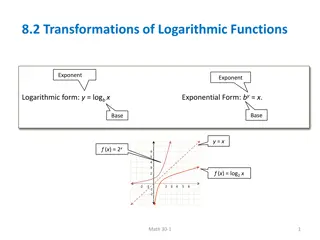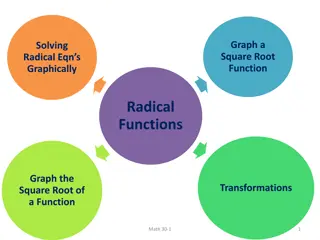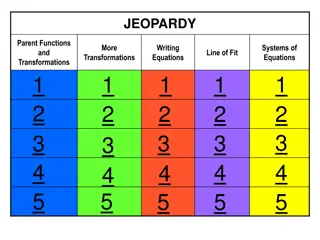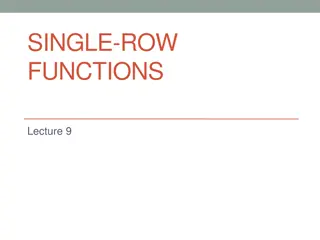
Understanding Function Transformations
Explore the concepts of vertical and horizontal translations, stretches, and compressions in functions. Learn how adding or subtracting constants affects the graph's position, and how multiplying by constants impacts vertical and horizontal scaling. Master the art of transforming functions with ease.
Download Presentation

Please find below an Image/Link to download the presentation.
The content on the website is provided AS IS for your information and personal use only. It may not be sold, licensed, or shared on other websites without obtaining consent from the author. If you encounter any issues during the download, it is possible that the publisher has removed the file from their server.
You are allowed to download the files provided on this website for personal or commercial use, subject to the condition that they are used lawfully. All files are the property of their respective owners.
The content on the website is provided AS IS for your information and personal use only. It may not be sold, licensed, or shared on other websites without obtaining consent from the author.
E N D
Presentation Transcript
? ? = ? ? ? ? ? + ? TRANSFORMATIONS OF FUNCTIONS Shifts and stretches
TRANSFORMATIONS OF FUNCTIONS Vertical Translation Horizontal Translation Vertical Stretches/Compressions Horizontal Stretches/Compressions
VERTICAL TRANSLATION Vertical translation (d) Consider the parent function of the parabolas, f(x)=x2, the black curve on the right. It's not too difficult to imagine that if we simply add a constant number (it's 2 in the figure) to every value of the function, we just raise (translate) the curve upward along the y-axis by 2 units. If we add a constant number, d, to a function, we translate it upward (d > 0) or downward (d < 0) along the y-axis by that amount.
HORIZONTAL TRANSLATION Horizontal translation (c) When a number, usually denoted by c, is subtracted from the independent variable insideof a function, the function is translated by c units to the right if c > 0 and to the left if c < 0. This can be tricky. Remember that the transformation is written f(x) f(x - c); the c is subtracted. When c is positive, the translation is in the positive x direction. When c is negative, (x-(-c)) = (x+c), and the translation is to the left. For example, f(x) = (x - 2)2is a parabola translated to the right by two units. f(x) = (x + 2)2is a parabola translated to the left by two units.
VERTICAL STRETCHES/COMPRESSIONS Vertical Stretches/Compressions (a) When a function is multiplied by a constant, usually denoted by a, the result is vertical scaling of the graph. In this case, f(x) becomes a f(x) When a > 1, the graph is stretched vertically. When 0 < a < 1, the graph is compressed vertically, and when a < 0, the graph is flipped or reflected across the x-axis
HORIZONTAL STRETCHES/COMPRESSIONS Horizontal Stretches/Compressions (b) When the independent variable is multiplied by a constant, usually denoted by b, the result is scaling of the graph along the x-axis. ? ? = 4?2 When 0 < b < 1, the graph is stretched horizontally (made wider). When b > 1, the graph is compressed (made smaller) horizontally, and when b < 0, the graph is reflected across the y- axis (and stretched or compressed depending on the absolute value of b).
Vertical translation Upward (d > 0) Downward (d < 0) TRANSFORMATIONS OF FUNCTIONS ? ? = ? ? ? ? ? + ? Vertical Stretches/ Compressions Stretch (a > 1) Compress (0 < a < 1) Horizontal translation Left (+c) Right (-c) Horizontal Stretches/ Compressions Stretch (0 < b < 1) Compress (b > 1)






















